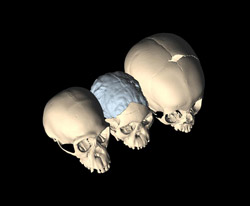Typically human brain development older than first thought

Skulls of a chimpanzee (left), the Taung Australopithecus africanus child (middle), and a modern human (right), all of age ~4 years.<br><br>computer-generated images by M. Ponce de León and Ch. Zollikofer, University of Zurich<br>
These appeared much earlier in the hominin family tree than was originally thought, as anthropologists from the University of Zurich who re-examined the Taung child’s fossil cranial sutures and compared them with other fossil skulls now prove. The late fusion of the cranial sutures in the Taung child is also found in many other members of the Australopithecus africanus species and the earliest examples of the Homo genus.
The Australopithecus child’s skull discovered in Taung in 1924 is an icon of human evolution. Of the neurocranium, the fossilized sediment filling has survived. The imprints of the original cerebral gyri on this rock core have fascinated paleoanthropologists from the outset and triggered much debate on the evolution of the Australopithecus brain.
Fossil cranial sutures cast in whole new light
The imprints of the cranial sutures that are also clearly visible on the rock core had long been forgotten. Now, anthropologists from the University of Zurich teamed up with researchers from Florida State University to examine their importance for brain growth in the Taung child. Sutures are bone growth fronts where the neurocranium can expand as the brain grows. Once the brain stops growing, the sutures ossify. The Taung child, who died at about four years of age, has something unusual: a suture between the two halves of the frontal bone. According to the research team’s analyses, this so-called metopic suture is already ossified in most chimpanzees of the Taung child’s age, but often is not in human children of the same age.
Typical brain development older than thought
As the researchers now demonstrate using computer-imaging comparisons of fossil crania, the late fusion of the metopic suture in the Taung child is not unique in fossils. It is also found in many other members of the species Australopithecus africanus, not to mention the earliest examples of our Homo genus. The three typical hallmarks of human brain development – a large neonate brain, rapid brain growth and large frontal lobes – therefore appeared much earlier in the hominin family tree than was originally thought.
Fast-growing brain behind late fusion
“The late fusion of the metopic suture in humans is linked to our special brain growth,” explains Marcia Ponce de León, a senior lecturer at the University of Zurich’s Anthropological Institute. A new-born human’s brain is as big as an adult chimpanzee’s. Accordingly, the cranium, which is deformed as it passes through the mother’s pelvis, is also large. This is only possible because all the cranial sutures are still wide open. After birth, the human brain grows extremely quickly, especially the large frontal lobes. “The late fusion of the metopic suture must be directly linked to this,” adds Ponce de León. In chimpanzees, these problems do not exist. Their neonates’ heads are comparatively small, their brain growth slows shortly after birth and the frontal lobes are not as pronounced. Consequently, the metopic suture also ossifies early.
Further reading:
Dean Falk, Christoph P. Zollikofer, Naoki Morimoto and Marcia S. Ponce de León. Metopic suture of Taung (Australopithecus africanus) and its implications for hominin brain evolution. PNAS, May 7, 2012. doi/10.1073/pnas.1119752109
Contact:
Dr. Marcia Ponce de León
Anthropological Institute
University of Zurich
Tel.: +41 44 635 54 27
Email: marcia@aim.uzh.ch
Media Contact
More Information:
http://www.uzh.chAll latest news from the category: Life Sciences and Chemistry
Articles and reports from the Life Sciences and chemistry area deal with applied and basic research into modern biology, chemistry and human medicine.
Valuable information can be found on a range of life sciences fields including bacteriology, biochemistry, bionics, bioinformatics, biophysics, biotechnology, genetics, geobotany, human biology, marine biology, microbiology, molecular biology, cellular biology, zoology, bioinorganic chemistry, microchemistry and environmental chemistry.
Newest articles

Superradiant atoms could push the boundaries of how precisely time can be measured
Superradiant atoms can help us measure time more precisely than ever. In a new study, researchers from the University of Copenhagen present a new method for measuring the time interval,…

Ion thermoelectric conversion devices for near room temperature
The electrode sheet of the thermoelectric device consists of ionic hydrogel, which is sandwiched between the electrodes to form, and the Prussian blue on the electrode undergoes a redox reaction…

Zap Energy achieves 37-million-degree temperatures in a compact device
New publication reports record electron temperatures for a small-scale, sheared-flow-stabilized Z-pinch fusion device. In the nine decades since humans first produced fusion reactions, only a few fusion technologies have demonstrated…





















